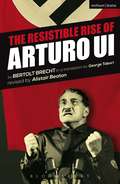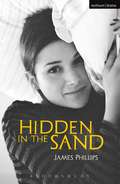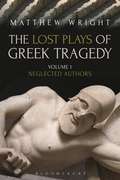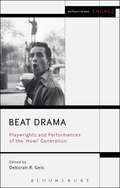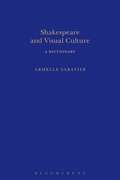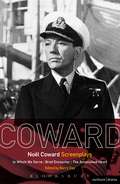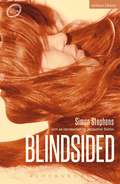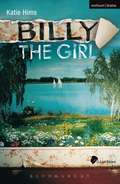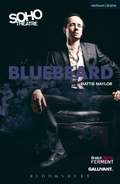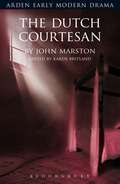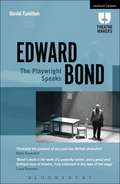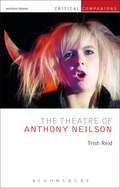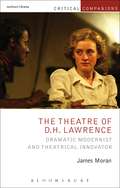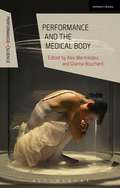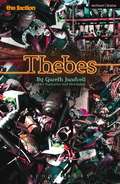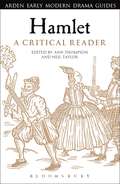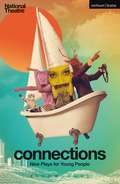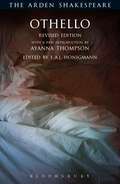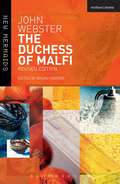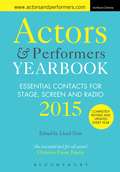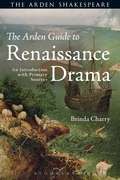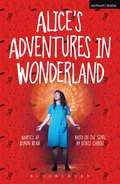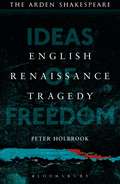- Table View
- List View
The Resistible Rise of Arturo Ui (Modern Plays)
by Bertolt Brecht Alistair Beaton George TaboriDescribed by Brecht as 'a gangster play that would recall certain events familiar to us all', The Resistible Rise of Arturo Ui is a witty and savage satire of the rise of Hitler – recast by Brecht into a small-time Chicago gangster's takeover of the city's greengrocery trade. Using a wide range of parody and pastiche – from Al Capone to Shakespeare's Richard III and Goethe's Faust – Brecht's compelling parable continues to have relevance wherever totalitarianism appears today.Written during the Second World War in 1941, the play was one of the Berliner Ensemble's most outstanding box-office successes in 1959, and has continued to attract a succession of major actors, including Leonard Rossiter, Christopher Plummer, Antony Sher and Al Pacino.This version, originally translated by George Tabori, has been revised by leading Scottish playwright Alistair Beaton.
Hidden in the Sand (Modern Plays)
by James PhillipsSometimes we don't live, we cope. I have coped, not lived, for a long time. So have you I think.A passionate love story set between London and Cyprus. Alexandra, a refugee from the Turkish invasion of Cyprus in 1974, has made a home in London and cocooned herself from ghosts of the past. There, she meets Jonathan, an English classical scholar, who falls deeply in love with her. Against a backdrop of war and the partition of countries, can love overcome the grief of the past?
Shakespeare and Feminist Theory (Shakespeare and Theory)
by Marianne NovyAre Shakespeare's plays dramatizations of patriarchy or representations of assertive and eloquent women? Or are they sometimes both? And is it relevant, and if so how, that his women were first played by boys? This book shows how many kinds of feminist theory help analyze the dynamics of Shakespeare's plays. Both feminist theory and the plays deal with issues such as likeness and difference between the sexes, the complexity of relationships between women, the liberating possibilities of desire, what marriage means and how much women can remake it, how women can use and expand their culture's ideas of motherhood and of women's work, and how women can have power through language. This lively exploration of these and related issues is an ideal introduction to the field of feminist readings of Shakespeare.
The Lost Plays of Greek Tragedy: Neglected Authors (Volume #1)
by Matthew WrightNumerous books have been written about Greek tragedy, but almost all of them are concerned with the 32 plays that still survive. This book, by contrast, concentrates on the plays that no longer exist. Hundreds of tragedies were performed in Athens and further afield during the classical period, and even though nearly all are lost, a certain amount is known about them through fragments and other types of evidence. Matthew Wright offers an authoritative two-volume critical introduction and guide to the lost tragedies. This first volume examines the remains of works by playwrights such as Phrynichus, Agathon, Neophron, Critias, Astydamas, Chaeremon, and many others who have been forgotten or neglected. (Volume 2 explores the lost works of Aeschylus, Sophocles and Euripides.)What types of evidence exist for lost tragedies, and how might we approach this evidence? How did these plays become lost or incompletely preserved? How can we explain why all tragedians except Aeschylus, Sophocles and Euripides became neglected or relegated to the status of 'minor' poets? What changes and continuities can be detected in tragedy after the fifth century BC? Can the study of lost works and neglected authors change our views of Greek tragedy as a genre? This book answers such questions through a detailed study of the fragments in their historical and literary context. Including English versions of previously untranslated fragments as well as in-depth discussion of their significance, The Lost Plays of Greek Tragedy makes these works accessible for the first time.
Beat Drama: Playwrights and Performances of the 'Howl’ Generation (Methuen Drama Engage)
by Deborah Geis Enoch Brater Mark Taylor-BattyReaders and acolytes of the vital early 1950s-mid 1960s writers known as the Beat Generation tend to be familiar with the prose and poetry by the seminal authors of this period: Jack Kerouac, Gregory Corso, Lawrence Ferlinghetti, Diane Di Prima, and many others. Yet all of these authors, as well as other less well-known Beat figures, also wrote plays-and these, together with their countercultural approaches to what could or should happen in the theatre-shaped the dramatic experiments of the playwrights who came after them, from Sam Shepard to Maria Irene Fornes, to the many vanguard performance artists of the seventies. This volume, the first of its kind, gathers essays about the exciting work in drama and performance by and about the Beat Generation, ranging from the well-known Beat figures such as Kerouac, Ginsberg and Burroughs, to the "Afro-Beats†? - LeRoi Jones (Amiri Baraka), Bob Kaufman, and others. It offers original studies of the women Beats - Di Prima, Bunny Lang - as well as groups like the Living Theater who in this era first challenged the literal and physical boundaries of the performance space itself.
Shakespeare and Visual Culture (Arden Shakespeare Dictionaries)
by Armelle SabatierStatues coming to life and lively portraits ready to breathe in Shakespeare? This new volume re-assesses the key role played by visual culture in his drama and poetry by providing readers with an up-to-date guide to the main publications on the subject as well as offering a synthesis on the main literary and historical sources for inspiration. While scrutinising the complex issue of image on an Elizabethan stage and exploring the codification of colours in Shakespeare's poetry, this dictionary highlights the fierce rivalry between the poet, the dramatist and the visual artist. This volume will be of great interest and value to students of Shakespeare, students of art history or anyone working on the interdisciplinary subject of literature and art.
Noël Coward Screenplays: In Which We Serve, Brief Encounter, The Astonished Heart
by Noël Coward Barry DayThis collection brings together three of Coward's most important screenplays – In Which We Serve (1942), Brief Encounter (1945) and The Astonished Heart (1950). The collection features the shooting scripts for each film alongside contextual notes for each play, and a general introduction, by Barry Day. In Which We Serve earned Coward an Academy Honorary Award in 1943 as well as the New York Film Critics Circle Award for Best Film. The film remains a classic of wartime British cinema. Brief Encounter, the most famous screenplay in this collection, is based on Coward's 1936 one-act play Still Life. It remains one of the greatest love stories of all time, coming second in a British Film Institute poll of the top 100 British films. The Astonished Heart tells the story of a psychiatrist's growing obsession for a good-time girl and the resulting tragedy this leads to. This collection features a foreword by Laurence Kardish, Senior Curator Emeritus, Film, at New York's MoMA, and an eight-page black and white plate section of production stills.
Blindsided (Modern Plays)
by Simon StephensWe're just the least lucky girls in all the world. All three of us. You and me and Ruthy have been given a big sad spoon of bad luck. A girl growing up in a battered part of Stockport in a battered time at the end of the Seventies falls in love with the man who will break her heart into a thousand pieces. Blindsided is a surprising and romantic play about warped love, jealousy, and damaged lives, spanning from the beginnings of the Thatcher Government in 1979 to the birth of New Labour in 1997.This edition features an introduction by Dr Jacqueline Bolton.
Billy the Girl (Modern Plays)
by Katie HimsI wish you could just like consider – consider the chance of it being an accident. 'Cos you're so sure. You're so sure that I did this awful thing. Billy is out waiting for love where she last saw it. Her mum is certain love has walked into her life again. Her sister thinks love could still be found somewhere in the house . . . but Billy herself isn't even allowed through the door. In Katie Hims's sweet, stark family elegy, love never dies, but sometimes – like Billy – it has to sleep in the caravan with Frank's ashes and a bear costume. Billy the Girl is a sharp, yet gentle, look at a fractured family dealing with a lifetime of mistrust.
Bluebeard (Modern Plays)
by Hattie NaylorThis is all we are. This is all sex is. The attempted obliteration of the self. That's why it's so brutal. All there is the plane of nature. It was what was before and will always be, and our complete annihilation, this leisurely murdered world, is after all, what is.Bluebeard invites you into his chamber to share in the violent passion of his deviant sexual acts. Will he excite you? Will he seduce you? Will he love you to death?With its provocative, intelligently handled exploration of sexually motivated violence, Bluebeard is a psycho-sexual, stark and violent reimagining of the famous fairy-tale.
The Dutch Courtesan (Arden Early Modern Drama)
by John Marston Karen BritlandThe Dutch Courtesan is a riotous tragicomedy that explores the delights and perils afforded by Jacobean London. While Freevill, an educated young Englishman and the play's nominal hero, frolics in the city's streets, taverns and brothels, Franceschina, his cast-off mistress and the Dutch courtesan of the play's title,laments his betrayal and plots revenge. Juxtaposing Franceschina's vulnerable financial position against the unappealing marital prospects available to gentry women, the play undermines the language of romance, revealing it to be rooted in the commerce and commodification. Marston's commentary on financial insecurity and the hypocritical repudiation of foreignness makes The Dutch Courtesan truly a document for our time.
Edward Bond: The Playwright Speaks (Theatre Makers)
by David Tuaillon Edward BondOver 50 years after his first appearance on the theatre scene, Edward Bond remains a hugely significant figure in the history of modern British playwriting. His plays are the subject of much debate and frequent misinterpretation, with his extensive use of allegory and metaphor to comment on the state of society and humanity in general leading to many academics, theatre practitioners and students trying - and often failing - to make sense of his plays over the years. In this unique collection, David Tuaillon puts these pressing questions and mysteries to Edward Bond himself, provoking answers to some of his most elusive dramatic material, and covering an extraordinary range of plays and subjects with real clarity. With a particular focus on Bond's later plays, about which much less has been written, this book draws together very many questions and issues within a thematic structure, while observing chronology within that.Edward Bond: The Playwright Speaks is potentially the most comprehensive, precise and clear account of the playwright's work and time in the theatre to date, distilling years and schools of thought into one single volume.Published to mark the 50th anniversary of the first performance of Edward Bond's Saved at the Royal Court Theatre in 1965.
The Theatre of Anthony Neilson (Critical Companions)
by Trish ReidAnthony Neilson is one of the most exciting and challenging voices in contemporary British theatre. For more than two decades he has been in the vanguard of new writing and has acquired a formidable reputation for innovation and experimentation. His major stage plays include Penetrator, The Censor, Stitching, Realism, Unreachable and his 2004 masterpiece The Wonderful World of Dissocia, arguably one of the finest Scottish plays of the new millennium. This volume provides the first full-length study of Neilson's plays and his innovative rehearsal methodology. As well as providing a detailed account of each play Trish Reid includes an extensive new interview with Neilson and additional contributions from important scholars and commentators in the field. This is essential reading for anyone who wants to develop a better understanding of one of British theatre's most original artists.
The Theatre of D.H. Lawrence: Dramatic Modernist and Theatrical Innovator (Critical Companions)
by James MoranThis is the first major book-length study for four decades to examine the plays written by D. H. Lawrence, and the first ever book to give an in-depth analysis of Lawrence's interaction with the theatre industry during the early twentieth century. It connects and examines his performance texts, and explores his reaction to a wide-range of theatre (from the sensation dramas of working-class Eastwood to the ritual performances of the Pueblo people) in order to explain Lawrence's contribution to modern drama. F. R. Leavis influentially labelled the writer 'D. H. Lawrence: Novelist'. But this book foregrounds Lawrence's career as a playwright, exploring unfamiliar contexts and manuscripts, and drawing particular attention to his three most successful works: The Widowing of Mrs Holroyd, The Daughter-in-Law, and A Collier's Friday Night. It examines how Lawrence's novels are suffused with theatrical thinking, revealing how Lawrence's fictions – from his first published work to the last story that he wrote before his death – continually take inspiration from the playhouse. The book also argues that, although Lawrence has sometimes been dismissed as a restrictively naturalistic stage writer, his overall oeuvre shows a consistent concern with theatrical experiment, and manifests affinities with the dramatic thinking of modernist figures including Brecht, Artaud, and Joyce. In a final section, the book includes contributions from influential theatre-makers who have taken their own cue from Lawrence's work, and who have created original work that consciously follows Lawrence in making working-class life central to the public forum of the theatre stage.
Performance and the Medical Body (Performance and Science: Interdisciplinary Dialogues)
by Alex Mermikides Gianna Bouchard Nicola Shaughnessy John LutterbieThis edited collection focuses on performance practice and analysis that engages with medical and biomedical sciences. After locating the 'biologization' of theatre at the turn of the twentieth century, it examines a range of contemporary practices that respond to understandings of the human body as revealed by biomedical science. In bringing together a variety of analytical perspectives, the book draws on scholars, scientists, artists and practices that are at the forefront of current creative, scientific and academic research. Its exploration of the dynamics and exchange between performance and medicine will stimulate a widening of the debate around key issues such as subjectivity, patient narratives, identity, embodiment, agency, medical ethics, health and illness. In focusing on an interdisciplinary understanding of performance, the book examines the potential of performance and theatre to intervene in, shape, inform and extend vital debates around biomedical knowledge and practice in the contemporary moment.
Thebes (Modern Plays)
by Gareth Jandrell Sophocles AeschylusI mean, what is Thebes? A theocracy? No. A meritocracy? Certainly not. A monarchy? Kind of. A patriarchy? Less and less so. Thebes is many things, and to revolutionise that? Well, how?From Oedipus to Antigone, the story of Thebes remains a fascinating exploration of fate, morality and chaos, two and a half thousand years after the saga was originally written.The first domino falls as Oedipus realises he has unwittingly fulfilled a cruel and unusual prophecy. As control of Thebes is handed to Creon, his sons fight each other for the kingdom and his daughter Antigone is determined to serve the honour of her family to the bitter end.This version weaves together Sophocles and Aeschylus to present the full, visceral and bloody account of the Oedipus dynasty.
Hamlet: A Critical Reader (Arden Early Modern Drama Guides)
by Ann Thompson Neil TaylorHamlet remains the most-studied of all Shakespeare's great tragedies. This collection of newly-commissioned essays gives readers an overview of past critical views of the play as well as new writing about the play from today's leading scholars. The range of perspectives offered makes the book an invaluable companion to anyone studying the play at an advanced level. The final chapter on learning and teaching resources is particularly useful as a guide for further study.
National Theatre Connections 2014: Plays for Young People: Same; Horizon; The Wardrobe; Heritage; A Letter to Lacey; A Shop Selling Speech; Angels; Hearts; Pronoun; Tomorrow
by Sabrina Mahfouz Simon Vinnicombe Catherine Johnson Pauline McLynn Dafydd James Luke Norris Sam Holcroft Matt Hartley Deborah Bruce Evan Placey Anthony BanksDrawing together the work of ten leading playwrights - a mixture of established and emerging writers - this National Theatre Connections anthology is published to coincide with the 2014 festival, which takes place across the UK and finishes up at the National Theatre in London. It offers young performers between the ages of thirteen and nineteen everywhere an engaging selection of plays to perform, read or study. Each play is specifically commissioned by the National Theatre's literary department with the young performer in mind. The plays are performed by approximately 200 schools and youth theatre companies across the UK and Ireland, in partnership with multiple professional regional theatres where the works are showcased.As with previous anthologies, the volume will feature an introduction by Anthony Banks, Associate Director of the National Theatre Discover Programme, and each play includes notes from the writer and director addressing the themes and ideas behind the play, as well as production notes and exercises.The National Theatre Connections series has been running for nineteen years and the anthology that accompanies it, published for the last three years by Methuen Drama, is gaining a greater profile by the year. Some iconic plays have grown out of the Connections programme including Citizenship by Mark Ravenhill, Burn by Deborah Gearing, Chatroom by Enda Walsh, Baby Girl by Roy Williams, DNA by Dennis Kelly, and The Miracle by Lin Coghlan. The series has a recognisable brand and the anthologies continue to be an extremely useful resource, their value extending well beyond their year of publication.This year's anthology includes plays by Sabrina Mahfouz, Simon Vinnicombe, Catherine Johnson, Pauline McLynn, Dafydd James, Luke Norris and Sam Holcroft.
Othello: Revised Edition (The Arden Shakespeare Third Series)
by William Shakespeare Ayanna Thompson E.A.J. HonigmannThis second edition of Othello has a new, illustrated introduction by leading American scholar Ayanna Thompson, which addresses such key issues as race, religion and gender, as well as looking at ways in which the play has been adapted in more recent times.Othello is one of Shakespeare's great tragedies-written in the same five-year period as Hamlet, King Lear, and Macbeth. The new introduction attends to the play's different meanings throughout history, while articulating the historical context in which Othello was created, paying particular attention to Shakespeare's source materials and the evidence about early modern constructions of racial and religious difference. It also explores the life of the play in different historical moments, demonstrating how meanings and performances develop, accrue, and metamorphose over time. The volume provides a rich and current resource, making this best-selling play edition ideal for today's students at advanced school and undergraduate level.
The Duchess of Malfi (New Mermaids)
by John Webster Brian GibbonsA major revision of this classic revenge tragedy. The comprehensive introduction covers recent developments in criticism and key theatre productions, as well as relating the play to other early modern tragedies. The edition gives students and teachers a reliable, annotated text and a stimulating overview of the play's context, critical perspectives and an exploration of its stage history. An invaluable resource for study and performance.
Actors and Performers Yearbook 2015
by Lloyd TrottActors and Performers Yearbook is an established and respected directory that enables actors to find work in stage, screen and radio. It is the only directory to provide detailed information for each listing and specific advice on how to approach companies and individuals, saving hours of further research. From agents and casting directors to producing theatres, showreel companies and photographers, Actors and Performers Yearbook editorially selects only the most relevant and reputable contacts for the actor.Formerly known as Actors' Yearbook, Actors and Performers Yearbook features articles and commentaries, providing valuable insight into the profession: auditions, interviews and securing work alongside a casting calendar and advice on contracts and finance. This is an incredibly useful professional tool in an industry where contacts and networking are key to career survival.The listings detailed in this edition have been thoroughly updated alongside fresh advice from industry experts.
The Arden Guide to Renaissance Drama: An Introduction with Primary Sources
by Brinda CharryThe Arden Guide to Renaissance Drama is a single critical and contextual resource for students embarking on an in-depth exploration of early modern drama, providing both critical insight and accessible contextual information. This companion equips students with the information needed to situate the plays in their socio-political, intellectual and literary contexts. Divided into two parts, it introduces students to the major authors and significant dramatic texts of the period and emphasises the importance of both a historicist and close-reading approach to better engage with these works.The Guide offers:· primary texts from key early modern scholars such as Machiavelli, Heywood and Sidney· contextual information vital to a full understanding of the drama of the period· close readings of 14 of the most widely studied play texts by Shakespeare and his contemporaries· a single resource to accompany any study of early modern dramaThis is an ideal companion for students of Renaissance drama, offering students and teachers a range of primary contextual sources to illuminate their understanding alongside close critical readings of the major plays of the period.
Alice's Adventures in Wonderland (Modern Plays)
by Lewis Carroll Simon ReadeWhen Alice falls down a mysterious rabbit hole she stumbles upon a magical fantasy world where anything can happen . . . Take tea with the Mad Hatter, meet the White Rabbit, grin with the Cheshire Cat, and play croquet with the Queen of Hearts, but whatever you do . . . don't lose your head!Lewis Carroll's classic characters spring to life in an enchanting show for the whole family, bursting with music, madness and mystery.Simon Reade's adaptation of Lewis Carroll's much-loved fantasy classic Alice's Adventures in Wonderland is a witty and brilliantly inventive re-working, which won the TMA Award for Best Show for Young People.
English Renaissance Tragedy: Ideas of Freedom
by Peter HolbrookThis book's underlying claim is that English Renaissance tragedy addresses live issues in the experience of readers and spectators today: it is not a genre to be studied only for aesthetic or “heritage” reasons. The book considers the way in which tragedy in general, and English Renaissance tragedy in particular, addresses ideas of freedom, understood both from an individual and a sociopolitical perspective. Tragedy since the Greeks has addressed the constraints and necessities to which human life is subject (Fate, the gods, chance, the conflict between state and individual) as well as the human desire for autonomy and self-direction. In short, English Renaissance Tragedy: Ideas of Freedom shows how the tragic drama of Shakespeare's age addresses problems of freedom, slavery, and tyranny in ways that speak to us now.
Shakespeare and Cultural Materialist Theory (Shakespeare and Theory)
by Christopher MarlowCultural materialism is one of the most important and one of the most provocative theories to have emerged in the last thirty years. Combining close attention to Shakespearean texts and the conditions of their production with an explicit left-wing political affiliation, cultural materialism offers readers a radical avenue through which to engage with Shakespeare and his world. Shakespeare and Cultural Materialist Theory charts the inception and development of this theory, setting out its central tenets and analysing the work of key thinkers such as Alan Sinfield, Jonathan Dollimore, Terence Hawkes and Catherine Belsey. Unlike most literary theories, cultural materialism attempts to use the study of Shakespeare to intervene in the politics of the present day, and its unsettling approach has not passed without objection, both within academia and without. This book considers the debates, scandals and controversies caused by cultural materialism, and by applying it to Shakespeare afresh, demonstrates that the theory is still very much alive and kicking.
